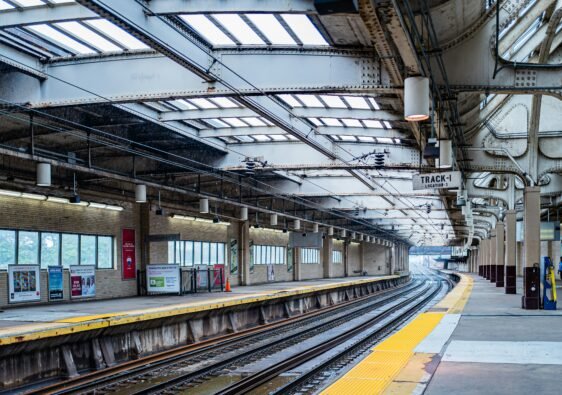Amtrak’s Northeast Corridor runs from Washington, DC to Boston, MA. More than 100 trains race up and down this line daily. From the Northeast Regional, to the Acela Express, to the Keystone, and long-distance trains, the Northeast Corridor is the busiest railroad line in the United States. Previously, the highlights between New York and Washington, DC were shared. In contrast to the New York-Washington, DC part of the route, the New York-Boston portion is by far the most scenic. Now, it’s time to climb aboard and experience the top five highlights between New York and Boston.
#5 Hell Gate Bridge: The passengers have boarded at New York Penn Station’s Moynihan Hall. Leaving the station, the train accelerates and passes through the 4 and a half mile long East River Tunnel. The trains pass through this tunnel at approximately 55 miles per hour. Emerging from the East River Tunnel in Sunnyside, Queens, the train continues northeast through Astoria, Queens. Minutes later, the train is traveling on the three mile long Hell Gate Bridge. The Hell Gate Bridge was built in 1910. The Hell Gate Bridge was built to connect Sunnyside, Queens and Oak Point in the Bronx. The tracks on the Hell Gate Bridge were once known as the New York Connecting Railroad, which connected the Pennsylvania Railroad to the New Haven Railroad near New Rochelle, NY. The arch across the Hell Gate is the largest of three bridges that form the Hell Gate viaduct. The Tyne Bridge in England and the Sydney Harbour Bridge in Australia were both modeled after the Hell Gate Bridge. On board, the best time to take photographs is in the morning with the sun rising in the east-a sight to behold.
#4 Mianus River Bridge: North of New Rochelle, the scenery begins to put on its show. Having crossed the Connecticut state line, the train crosses over the Mianus River. Here, passengers should keep their cameras out. Out the left window, passengers can spot Interstate 95. To the right, passengers catch a glimpse of Long Island Sound. This is the first look at Long Island Sound until passengers see it again near Bridgeport. Many of the bridges including the Mianus River Bridge are bascule bridges, or draw bridges.
#3 Thames River Bridge: If there isn’t a more beautiful river crossing on the Northeast Corridor, it’s the Thames River Bridge in New London, CT. The Thames River is a short river and tidal estuary in northeastern Connecticut. It flows south for 15 miles through eastern Connecticut from the junction of the Yantic and Shetucket Rivers in Norwich, through Groton and New London before emptying into Long Island Sound. In June 2008, Amtrak replaced the 97-year old bascule bridge with a modern lift bridge. On a daily basis, the Thames River Bridge opens for marine traffic more than four times per day and serves up to 40 Amtrak trains, plus two freight trains per day. When crossing the Thames River Bridge, passengers are encouraged to have their cameras out for the photograph opportunity. Passengers can capture a gaping photograph of Long Island Sound to the east and the US Coast Guard pier upriver to the west. There, the U.S. Coast Guard sailing vessel “Eagle” is docked.
#2 Kingston Station: Accelerating towards Providence, Northeast Regional trains make a station stop at Kingston. Kingston is the home of the University of Rhode Island. Kingston Station is a local historic landmark. The station was built in 1875, by the New York, Providence, & Boston Railroad. The station was built to replace earlier successors dating back to the completion of the line in 1837. The station’s interior is just as quaint and cozy as it was in its hay day. Today, Kingston Station is a busy station for college students, but an ideal place for railfanning. When Amtrak’s Acela Express races through, it is a show like no other. Amtrak passengers waiting to board at Kingston are in for a treat. Cameras are ready. Passengers should skip still photography and record the action on video. Amtrak’s Acela Express races through at its highest sustained speed of 150 mph. Like a speeding bullet, Amtrak’s Acela Express roars through the station. The automated voice comes on saying, “Train approaching…please stand behind yellow line!”. Once passengers here the announcement, they know why.
#1 Boston South Station: Seventy miles north of Kingston, the train reaches its final destination. Boston South Station is a city landmark with a rich history. The historic South Station, opened in 1898, now serves thousands of commuters, travelers, shoppers, and diners each day. One of three Amtrak stations serving central Boston, South Station is the northern terminus of the busy Northeast Corridor. South Station once served the New Haven Railroad, the Boston & Albany Railroad, the New England Railroad, the Boston & Providence Railroad, and the Old Colony Railroad. Locals and tourists alike know the building for its gently curving facade and eagle-topped clock. The seaport district is a quick ten minutes away, including the Black Falcon Cruise Terminal. Today, the interior of South Station is ultra modern, with just the station’s exterior shell standing. Despite its mixed looks, South Station is a photograph opportunity for all travelers both young and old who visit Boston on an annual basis.




